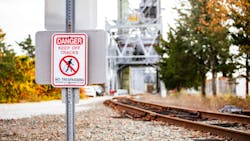Four Best Practices for Using AI to Prevent Rail Trespassing
Trespassing remains one of the leading causes of rail-related deaths in the U.S., creating safety risks for passengers, rail workers and communities. Traditional deterrents like signage, fencing, anti-trespass panels, enforcement are invaluable but impractical to have 100% coverage of the right-of-way. Advances in artificial intelligence (AI) are giving transit agencies new tools to address this persistent challenge.
Based on recent research and testing at the Transportation Technology Center, here are the four best practices transit leaders can apply when considering AI-enabled trespass detection and prevention.
Best practice 1: Start with data-driven hotspot analysis
Agencies should identify trespassing hotspots using a mix of historical incident reports, physical evidence and mobile data analytics. The latest AI enables mobile data to be utilized to identify trespasser hotspots that would otherwise go unnoticed until it’s too late. This ensures limited resources are focused on the areas where trespasser prevention technologies will deliver the greatest impact.
Best practice 2: Funding for trespasser prevention
With tight budgets, obtaining funding for trespasser prevention infrastructure and technology is a challenge. Many grants from the Federal Railroad Administration and Federal Transit Administration provide a means for agencies to obtain funds to help reduce trespasser causalities.
Best practice 3: Prioritized implementation
It's impractical for any agency to have 100% coverage of anti-trespasser infrastructure. However, by leveraging AI-identified hotspot with obtained implementation funding, a transit agency can prioritize locations to make improvements making the greatest impact to reducing trespassing.
Best Practice 4: Post-upgrade assessment
Following the implementation of anti-trespasser infrastructure and technology, the same AI technology to identify trespasser hotspots can also be used to assess if the upgrade obtained the desired effect. This ensures that the anti-trespasser measures were able to prevent the occurrences and not have them move to a different location.
Conclusion
AI is not a silver bullet, but it is a powerful tool to make rail corridors safer and reduce trespassing incidents. Transit leaders who take a thoughtful, data-driven approach can move from reactive measures to proactive prevention.
Want to learn more?
Read Samantha Kirkpatrick’s full article, How AI is Combating Rail Trespassing.
About the Author

Acacia Reber
head of brand strategy and engagement
Acacia Reber, MBA, is the head of brand strategy and engagement for ENSCO, Inc., which operates the Transportation Technology Center in Pueblo, Colorado.
